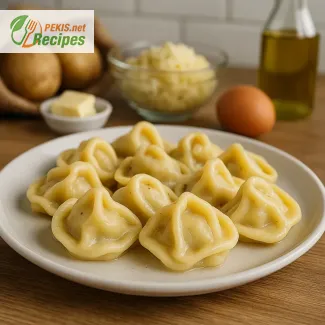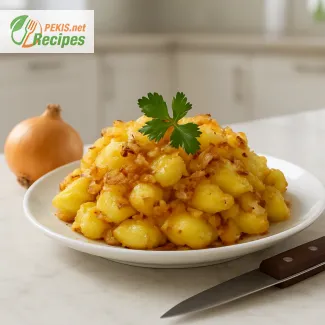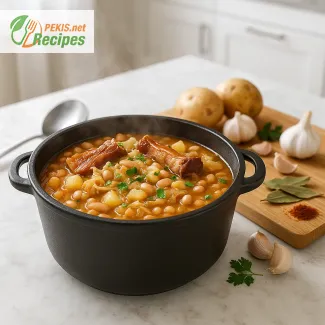
Discover the Taste of Slovenia’s Culinary Heritage
A traditional potato-filled dumpling from Idrija with centuries of local pride
Hidden in the alpine heart of Slovenia, the old mining town of Idrija holds more than just historical treasures—it's also the birthplace of one of the country’s most iconic traditional dishes: Idrijski žlikrofi. These small, crescent-shaped potato dumplings are a beloved staple of Slovenian home cooking, celebrated for their delicate texture, subtle seasoning, and instantly recognizable hat-like fold. Whether served with a rich meat sauce like “bakalca” or enjoyed as a standalone comfort dish, Idrijski žlikrofi are more than food—they're a national symbol.
Their distinctive shape and hand-crafted preparation have earned them Traditional Specialty Guaranteed (TSG) status by the European Union, elevating them beyond the borders of Slovenia and into kitchens across Europe and beyond. Yet despite this growing global interest, žlikrofi remain a deeply regional culinary tradition, passed down through generations, often prepared in the same meticulous way as our grandmothers once did.
What makes Idrijski žlikrofi so unique?
Unlike Italian gnocchi or Polish pierogi, these Slovenian dumplings are filled with a spiced potato-onion mixture, wrapped in delicate pasta dough and pinched into their signature “hat” form. This form isn’t just aesthetic—it ensures even cooking and offers the perfect balance between soft filling and tender pasta. They’re typically served as a main dish or a side, and their versatility makes them an ideal base for hearty sauces, vegetarian toppings, or festive Sunday meals.
The recipe calls for basic pantry ingredients—potatoes, onions, lard or butter, marjoram, and a simple flour-based dough—but it's the preparation that truly defines them. From rolling and stretching the dough to pinching each dumpling into its signature shape, the process is as much a celebration of Slovenian culinary heritage as it is a meal.
A brief history of žlikrofi from Idrija
First documented in the 19th century, Idrijski žlikrofi were a vital part of a miner’s diet in Idrija. The mining community, surrounded by harsh terrain and cold winters, relied on satisfying, affordable, and warming dishes. Žlikrofi fit that purpose perfectly. Their small size made them ideal for rationing, and their robust nature allowed them to be stored and reheated without losing quality.
Over time, what started as working-class sustenance became a national delicacy, often prepared for family gatherings, festivals, and even diplomatic events. Today, žlikrofi represent not just a meal, but a story of community, endurance, and Slovenian identity.
Regional pride and EU protection
One of the few Slovenian dishes to receive EU Traditional Specialty Guaranteed protection, Idrijski žlikrofi are subject to strict preparation guidelines if they are to be sold under the protected name. This includes the proportions of ingredients, their characteristic shape, and preparation technique. This regulation ensures the tradition remains authentic and consistent, preserving both its flavor and heritage.
But at home, you’re free to adapt and experiment. While purists may insist on the exact historical methods, modern kitchens often simplify the process or give it a twist—adding herbs, changing the sauce, or using different fats in the dough. Still, at the heart of every variation is the same spirit of handmade craftsmanship and regional pride.
Why make them at home?
In today’s culinary landscape filled with ready-made meals and international fusions, preparing Idrijski žlikrofi at home is a way to reconnect with authentic European cooking. It’s a hands-on, meditative process, one that celebrates the value of slow food and intentional preparation. You don’t need to be Slovenian to fall in love with žlikrofi—you just need patience, a good rolling pin, and a desire to serve something truly heartfelt.
Whether you're exploring Eastern European cuisine for the first time, or you're a nostalgic Slovenian living abroad, learning how to prepare Idrijski žlikrofi brings with it a sense of connection, culture, and culinary curiosity. They freeze well, reheat beautifully, and offer a stunning presentation for dinner parties or cozy family meals.
Ingredients that speak to the land
What makes žlikrofi so comforting is their humble yet flavorful filling. They reflect the kind of food that nourishes body and soul: earthy potatoes, golden onions, savory cracklings or lard, and just enough spice to elevate without overwhelming. Fresh marjoram, when used generously, gives the filling its signature aroma—herbal, slightly floral, and distinctly Alpine.
The dough is equally simple: just flour, eggs, a splash of water, and a touch of oil or butter. Yet when kneaded properly and allowed to rest, it becomes the perfect wrapper, thin but resilient, stretching around each potato ball with just enough elasticity to form the classic shape.
The act of forming each dumpling is almost ceremonial. The small discs of dough are filled, folded, and pinched with care, creating a shape that resembles Napoleon’s hat—a reference that reflects the region’s historical ties and folklore. This process, repeated dozens of times per batch, is what makes žlikrofi a labor of love, well worth the effort.
What to serve with žlikrofi
Traditionally, žlikrofi are served with bakalca, a rich lamb and vegetable sauce native to the Idrija region. But modern variations include butter sage sauce, mushroom cream, browned butter with herbs, or even a meatless tomato-based gravy. The dumplings absorb sauces well, and their neutral filling allows them to shine in both rustic and refined preparations.
Whether served alongside roast meats, paired with seasonal vegetables, or offered as a vegetarian main, Idrijski žlikrofi hold their own on the plate. They’re the kind of food that makes memories, perfect for festive gatherings, heritage menus, or introducing friends to Slovenian cuisine.
A recipe with heart, heritage, and hands-on joy
Making Idrijski žlikrofi from scratch isn’t just about following steps—it's about reviving tradition in your kitchen. Each fold, each pinch, each small dumpling is a tribute to Slovenian families who’ve been making them for generations. And now, with the right recipe and a bit of practice, you can join that culinary story—from your own home.
1. Prepare the filling
Peel the potatoes and boil them in salted water until tender. Drain and let cool. Mash the potatoes thoroughly while still warm.
In a small pan, sauté the finely chopped onion in lard or butter until golden. Add the onion to the mashed potatoes, along with marjoram, salt, and black pepper. Mix well to form a uniform filling. Set aside to cool.
2. Make the dough
In a large bowl, mix the flour with salt. Add the egg, sunflower oil, and gradually add water while kneading. Work the dough until it becomes smooth and elastic (about 10 minutes). Wrap in cling film and let rest for 30 minutes at room temperature.
3. Shape the dumplings
Roll out the dough on a floured surface to about 2 mm (0.08 inch) thickness. Cut into rectangles approximately 4×4 cm (1.6×1.6 inch).
Place a small ball of filling (about 1 tsp) in the center of each square. Fold the dough over to form a half-moon shape, press the edges to seal, then bring both corners together and pinch to create the characteristic “hat” shape of Idrijski žlikrofi.
4. Cook the dumplings
Bring a large pot of salted water to a boil. Add the dumplings in batches and cook for 3–4 minutes or until they float to the surface and are tender. Remove with a slotted spoon.
5. Serving suggestion
Traditionally served with bakalca, a rich lamb and vegetable sauce. Alternatively, they pair beautifully with butter and sage, mushroom sauce, or browned butter with herbs.
Mastering Slovenian Dumplings with Creative Twists
Flavorful tips, common mistakes, and healthier adaptations of Idrijski žlikrofi
When you’ve learned how to shape and cook Idrijski žlikrofi, there’s a natural next step: making them your own. While tradition forms the heart of this dish, culinary creativity allows you to take it further—enhancing flavor, refining texture, or adapting it to fit dietary preferences. The key lies in understanding how each ingredient and technique influences the final result.
Upgrading the filling with aromatic depth
The traditional filling consists of potatoes, onions, lard or butter, and dried marjoram—simple, earthy, and comforting. But you can amplify the flavor by sautéing the onions with garlic or leeks, which introduce a sweet-savory aroma that complements the potatoes beautifully.
To add more richness and umami, try blending in a small amount of grated hard cheese such as aged Tolminc, parmesan, or pecorino. A spoonful of caramelized onions or finely chopped sautéed mushrooms can also elevate the depth of flavor without overpowering the dish’s delicate nature.
Using fresh herbs like thyme, parsley, or chives in moderation offers a subtle brightness that contrasts nicely with the dense filling. If you enjoy spice, a pinch of smoked paprika or white pepper can introduce gentle warmth without disrupting the original character of the žlikrofi.
Rethinking the dough for elasticity and taste
The standard dough made from flour, eggs, water, and oil works well, but a few changes can fine-tune both handling and taste. Replacing part of the water with milk softens the dough, making it more pliable and easier to seal. For a slightly firmer bite, incorporate semolina flour—this gives the dough more structure, helping it hold up better when boiled.
If you want to avoid eggs, especially for a plant-based version, you can substitute the egg with flaxseed meal or simply use a little more oil and water, though you’ll need to knead longer to reach the right consistency. Always rest the dough for at least 30 minutes before shaping to allow the gluten to relax—this makes rolling easier and prevents tearing.
Why homemade always wins
One of the greatest advantages of preparing žlikrofi from scratch is control. You choose the quality of your ingredients, the thickness of the dough, the balance of herbs, and the shape of each dumpling. Unlike store-bought or mass-produced versions, homemade žlikrofi contain no preservatives, additives, or shortcuts.
You also gain the freedom to adjust the recipe to seasonal availability. In the spring, add a touch of wild garlic or sautéed nettles to the filling. In colder months, use roasted garlic or even small amounts of smoked meats like pancetta to warm up the flavor profile.
Making žlikrofi at home is also an immersive experience. The process of rolling, filling, and shaping each dumpling connects you with a centuries-old tradition and turns cooking into a meditative, satisfying ritual.
Common mistakes to avoid
- Overfilling the dough: This can cause the dumplings to burst during cooking. Aim for no more than a teaspoon of filling per piece.
- Dough too thick or too thin: Rolling the dough too thick results in chewy, undercooked edges, while dough that's too thin can break during boiling. A 2 mm thickness is ideal.
- Skipping dough rest time: Dough that hasn’t rested is harder to roll and seal. Always allow it to rest properly.
- Under-seasoning the filling: Remember that potatoes are bland by nature. Don’t be afraid to use enough salt, herbs, and fat to bring out the flavor.
- Not sealing the edges well: Press firmly and consider using a touch of water to help the dough stick, especially if the dough has dried slightly during shaping.
Healthier ingredient swaps without sacrificing tradition
For a lighter version of žlikrofi, replace lard or butter with olive oil or plant-based margarine. While this slightly alters the flavor, it makes the dish suitable for those avoiding saturated fats.
To reduce the glycemic impact, you can try a mix of white potatoes and sweet potatoes or add a handful of cooked lentils into the mash. For the dough, using a blend of white and whole grain flour adds more fiber and nutrients, although it may slightly change the texture.
Those avoiding gluten can use gluten-free flour blends, though the elasticity may differ. In this case, adding a pinch of xanthan gum or using egg-based dough helps maintain shape and hold during cooking.
If dairy is a concern, choose plant-based butters or simply skip the dairy altogether in the filling—onions and marjoram provide plenty of flavor on their own when cooked well.
Sauce pairings that enhance the experience
While the traditional lamb-based bakalca sauce remains the go-to pairing, don’t hesitate to try alternatives. A mushroom cream sauce, sage brown butter, or even a light tomato-herb coulis can create stunning flavor contrasts.
Vegetarians may enjoy pairing žlikrofi with roasted root vegetables and herb oil, or topping them with a creamy cauliflower purée. Each of these sauces offers a different dimension, showcasing the dish’s versatility and its ability to shine across styles.
Bringing žlikrofi into modern meals
If you're short on time, make a large batch and freeze them—they store extremely well and can be boiled straight from frozen. For elegant dinners, try serving smaller portions with artistic plating, garnished with microgreens or edible flowers.
You can even shape the dough into bite-sized party appetizers, fill them with gourmet variations (truffle paste, ricotta-spinach mix, or beetroot mash), and present them as a modern twist at events or gatherings.
Whether kept entirely traditional or given a creative spin, Idrijski žlikrofi continue to impress with their timeless charm and remarkable adaptability.
Allergens present in the recipe:
- Gluten (from wheat flour)
- Eggs
- Dairy (if butter is used)
Substitution tips:
- Use gluten-free all-purpose flour mix to eliminate gluten.
- Replace the egg with 1 tbsp (15 ml) of flaxseed meal mixed with 3 tbsp (45 ml) water.
- Use plant-based butter to make it dairy-free.
Vitamins and minerals per serving (approximate):
- Vitamin B6: 0.45 mg – supports energy metabolism and brain health
- Vitamin C: 18 mg – contributes to immune function and antioxidant protection
- Potassium: 670 mg – essential for nerve function and fluid balance
- Iron: 2.1 mg – important for oxygen transport in the blood
- Magnesium: 38 mg – supports muscle and nerve function
- Calcium: 34 mg – helps maintain bone health
Antioxidants per serving (approximate):
- Marjoram (rosmarinic acid): 20 mg – reduces inflammation and supports digestion
- Onions (quercetin): 18 mg – promotes heart health and cellular protection
- Potatoes (vitamin C-related compounds): 10 mg – boosts immune response and skin health





